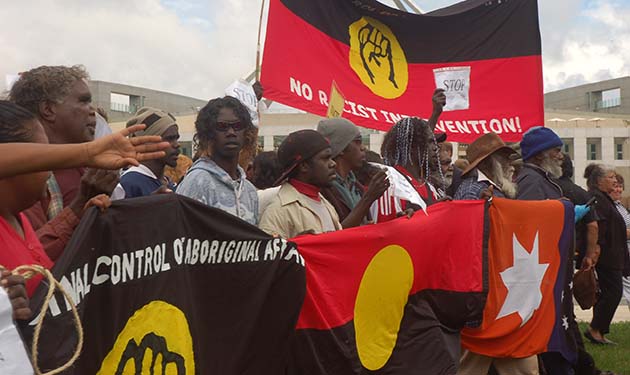In May this year, events were held to mark 50 years since the successful 1967 referendum, a campaign widely seen as winning full citizenship for Aboriginal people. But June is the ten-year anniversary of John Howard’s Northern Territory Intervention, a policy that has turned black people into second class citizens, once again.
The Intervention was based on the disgraceful lie that “pedophile rings” were operating in Aboriginal communities. The Australian Crime Commission was granted “star chamber powers” to investigate, but found there was no evidence of pedophile rings at all. But the vicious demonisation of Aboriginal culture, and Aboriginal men in particular, continues to do its damage.
Howard waged a long war on Aboriginal self-determination. He cut community organisations to pieces, gutted Native Title and then abolished representative body ATSIC in 2005.
Howard fought for a “white-blindfold” view of Australian history, denying Aboriginal genocide while celebrating the “achievements” of colonisation, including the mission system and Protection Acts that had subjugated Aboriginal people throughout the 20th Century.
The Intervention re-established a Protection regime in the NT, and brought a new wave of assimilationist policies. Introduced by Howard, it was shamefully rolled out, in 2008, by the incoming Rudd Labor government.
Labor delivered another blow to the anti-Intervention campaign in 2012, when it essentially extended the Intervention for a further ten years, under its “Stronger Futures in the Northern Territory” legislation.
Alcohol and pornography remain prohibited in Aboriginal communities. Police have massively expanded budgets and special powers to enter homes and vehicles on Aboriginal land without a warrant. The number of Aboriginal men in prison in the NT has doubled since 2007 and the number of female prisoners has increased more than four times over, making the NT a world leader in incarceration rates.
“Child protection” teams focus entirely on surveillance and removal of black children. The number of Aboriginal youth in detention has doubled and the number of children going into foster care is more than four times higher than 2007. Former NT Children’s Commissioner, Howard Bath, summed up the Intervention years, saying, “on the whole, the child well-being indicators in remote communities are getting worse”.
Child abuse
Ironically, while the Intervention was pitched as necessary to “save the children” from abuse, the Don Dale Royal Commission is currently investigating the systematic torture of Aboriginal children by government employees in detention centres. The Commission is also hearing of forced removals, with children taken hundreds of kilometres, denied their language and abused in foster care; treatment that is identical to that of the Stolen Generations of the past.
Just like the Protection regime that paid Aboriginal people in rations rather than cash, under the Intervention welfare payments are quarantined. Half is paid on “BasicsCards” that can only be used to buy “essential items”. But Aboriginal medical services are reporting widespread, chronic hunger in communities, with incomes cut because of Centrelink breaches.
Aboriginal unemployment rates across remote Australia have skyrocketed from 11 per cent before the Intervention, to 28 per cent today. Thousands of young black people aren’t even registered with Centrelink because of onerous conditions, and receive no income whatsoever.
Prior to 2007, the Community Development Employment Program (CDEP) paid poverty wages, but enabled Aboriginal people to make a life on their lands.
Howard, however, announced “Aboriginal people have no place outside the Australian mainstream” and that remote communities were “economically unviable”. The Intervention abolished CDEP to try and force people to migrate. Under a new scheme, CDP, people have to work 25 hours per week to receive quarantined welfare payments—approximately $5 cash per hour.
The racism and assimilation of the Intervention has set devastating new norms for Indigenous politics nationally. Now, the only government solutions for chronic poverty and associated social problems created by dispossession are various forms of welfare quarantining. A new “Healthy Welfare Card” is set for trial across regional and remote WA despite the enormous administrative cost and the documented failure of the BasicsCard.
The government decree that Aboriginal communities are not “economically viable” culminated in 2015 with the withdrawal of all Commonwealth funding for essential services for remote communities, followed with threats from the WA government to evict people.
In 2007, as the Intervention began, Aboriginal women from “prescribed areas” burned copies of the legislation. Years of campaigning has followed.
A protest convergence on 24 June in Alice Springs will mark ten years of the Intervention. In a welcome move the Australian Council of Trade Unions have formed the “First Nations Workers Alliance” to fight the CDP scheme. And the Don Dale Royal Commission is facing consistent protests.
For Aboriginal rights to go forward anywhere, the corrosive politics of the racist Intervention must be defeated.
By Paddy Gibson






